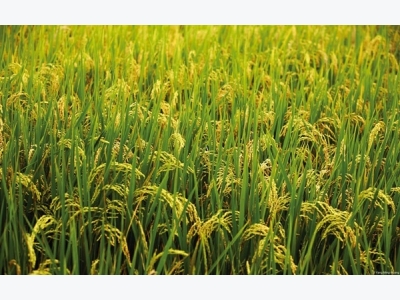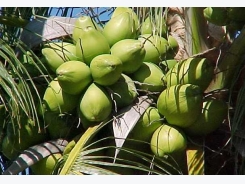Rice Farming Information Guide

Introduction of Rice Farming:- Rice is a cereal grain belongs to the grass family of Graminae and native to the deltas of the great Asian rivers, the Ganges, the Chang (Yangtze), and the Tigris and Euphrates. The rice plant grows from 2.5 to 6 ft tall, with a round, jointed stem, long pointed leaves and edible seeds borne in dense head on separate stalks. Rice is one of the most cultivated grain crops in India as well as in Asian countries and a staple diet of major part of India. People often confuses with paddy and rice. Rice when it is still covered by the brown hull is known as paddy. Rice fields are also called paddy fields or rice paddies. India is an important centre for Rice Farming and consumption. India stands in second position after China in the production of rice. Methods of growing rice differ greatly in different regions, but in most Asian countries including India, the traditional hand methods of cultivating and harvesting rice are still practiced. Modern farming of rice started in most of the countries which drastically reduced the labour problems and cost of cultivation. There are machines available from planting to harvesting the rice crop. Some parts of Asia rural areas still depend on the wet buffalos for land preparation and manpower in plantation and harvesting. Rice fields are also called paddy fields or rice paddies. South India consumes more rice than any part of India. Rice can be used to produce Rice bran oil from its husk apart from using in regular culinary purpose. There are many varieties of rice cultivated across India. With proper filed management practices and irrigation facility, rice farming would be the profitable in short period of time. However, in some parts of Asia, rice is being cultivated 3 times annually.

Ready to Harvest Matured Paddy
Health Benefits of Rice: – The following are the health benefits of rice.
- Rice is a good source of niacin, vitamin D, calcium, fiber, iron, thiamine & riboflavin.
- Rice is a good source of energy.
- Rice helps in cancer prevention.
- Rice helps in preventing skin problems.
- Rice is a cholesterol free food.
- Rice helps in blood Pressure management.
- Rice can also helps in preventing chronic constipation.
- Rice bran oil supports cardiovascular health.

Health Benefits of Rice
Local Names of Rice in Asia:– Rice (English), 米 (Chinese), Chawal (Hindi, India), ライス(Japanese), Chamal (Nepali), Chawal (Urdu), ขา้ว(Thai), cơm(Vietnamese), тутрага (Mongolian), 쌀(Korean), හා (Sinhalese, Sri Lanka), Рис (Russian), Pirinç(Turkish), 米(Taiwanese), الأرز) Arabic), Bigas (Filipino ).
Major Rice Production countries in Asia:- The following chart shows the list of rice producing countries
| Country | Population (mill.) 1995 | Annual Growth Rate (% per year) | Projected Population (mill.) in 2025 | Percent Increase 1995-2025 | |
| 1995-2000 | 2020-2025 | ||||
| China | 1199 | 0.9 | 0.5 | 1471 | 23 |
| India | 934 | 1.7 | 1.0 | 1370 | 47 |
| Indonesia | 192 | 1.4 | 0.8 | 265 | 38 |
| Bangladesh | 121 | 1.8 | 1.1 | 182 | 50 |
| Vietnam | 74.1 | 2.0 | 1.2 | 117 | 58 |
| Thailand | 60.5 | 1.3 | 0.7 | 80.8 | 34 |
| Myanmar | 46.8 | 2.1 | 1.1 | 72.9 | 56 |
| Japan | 125 | 0.3 | -0.3 | 124 | -1 |
| Philippines | 69.2 | 2.2 | 1.2 | 115 | 66 |
| Rep. of Korea | 44.8 | 0.8 | 0.3 | 52.9 | 18 |
| Pakistan | 130 | 2.7 | 1.6 | 243 | 87 |
Common/Local Names of Rice in India:- Chawal(Hindi), Biyyamu (Telugu), Pacharisi (Tamil), Pachari (Malayalam), Akki(Kannada), Chaal(Bengali),Taandul (Marathi),Thando (Konkani), Chaula (Oriya),Chawal (Punjabi), Chawal (Gujarati).
Major Rice Production States In India:– West Bengal, Uttar Pradesh, Andhra Pradesh, Telangana, Punjab, Bihar, Orissa, Chhattisgarh, Assam, Tamil Nadu, Haryana, Kerala.
Improved / Hybrid Varieties of Rice:- There are thousands of varieties of hybrid varieties of rice is available, contact your local seed manufacturer for high yield, disease resistant and which suitable to your region.

SRI – Hybrid Rice Field
Climate Requirement for Rice Farming:- Rice can be cultivated under widely varying conditions of altitude and climate. Rice can be cultivated as high as 3000 m (mean sea level). Basically Rice crop requires hot and humid climatic conditions for its successful rice farming. Rice crop is suited for the regions where abundant water supply, high humid weather and prolonged sunshine is available. The ideal temperature required throughout the life period of the crop ranges from 20°C to 40°C. However, the rice crop can tolerate the temperature up to 41°C to 42°C.
Soil Requirement for Rice Farming:- Rice can be cultivated on wide variety of soils such as silts, loams and gravels and can tolerate acidic as well as alkaline soils. However, deep fertile (rich in organic matter) clayey or loamy soils which can easily be puddled into mud and develop cracks on drying conditions are considered to be ideal for growing rice crop.
Propagation in Rice Farming:- Usually, Rice is Propagated through seeds.

Sprouted Paddy Seeds
Cultivation Methods in Rice Farming:- The following methods are practiced in the rice farming.
- Broadcasting method: In this method, Seeds are sown by hand and this method is suitable in areas where the soil is not fertile and lands are dry. This requires minimum labour and inputs. This method produces very less yield when compared to other sowing methods.
- Drilling method: In this method, Ploughing of land and sowing of seeds can be carried out by two persons. This sowing method is mostly confined to peninsular of India.
- Transplantation method: This is the most practiced method and this is followed in regions where soil has good fertility and abundant rainfall/irrigation. In these methods, paddy seeds are sown in nursery beds. Once seeds are germinated and seedlings are uprooted (Usually this will happen after 5 weeks), these seedlings can be transplanted in the main field. This method requires heavy labour and inputs. This method is proved to be best yielding method.

Preparation for Transplanting on Nursery Beds
Japanese method: High yielding varieties can be included in this method and which requires heavy dose of fertilizers. Seeds should be sown on raised nursery beds and should transplant the seedlings in rows. Weeding and fertigation should be carried out as per schedule. This method is successfully adopted for high yielding hybrid crops

Transplanting Rice with the help of Machine
Seed Selection in Rice Farming:- Seed selection in paddy cultivation plays major role in getting proper yield of the crop. Farmers are advised to select the best quality seeds to raise the healthy seedlings.
- The following are the steps need to be followed while selecting the seeds for quality.
- The selected seed should belong to the proper improved high yielding variety.
- The selected seed should be fully mature, well developed and plump in size.
- The selected seed should be free from signs of age or bad storage
- The selected seed should be clean and free from mixtures of other seeds.
- The selected seed should have a high germinating capacity for getting higher yields.
Note: Before sowing the seeds in the field, they should be treated with fungicides to protect the seed from soil-born fungi disease and also to give a boost to the seedlings.
Seed Treatment in Rice Farming:- The paddy seeds should be treated with Agrosan @ 100 grams per 50 Kg of paddy seeds to prevent seed-borne diseases. The untreated high yielding varieties of rice should be soaked for 12 hours in a solution of wettable ceresan (0.1%). After this, make sure to thoroughly dry in shade before sowing in the field or nursery bed.
Land Preparation, Spacing and Sowing in Rice Farming:- The primary systems followed in Rice Farming are ‘dry’, ‘semi-dry’ and ‘Wet’. Basically, the dry and semi-dry systems of cultivation depends on rains and do not have supplementary irrigation facilities where as In wet cultivation system, the rice crop is grown with assured and abundant water supply either by rain or by irrigation.
- Dry and Semi-dry systems: for this system of rice crop the field should have good tilth that can be achieved by giving couple of ploughings & harrowing. Filed should be supplemented with farm yard manure (FMY)/compost DISTRIBUTED uniformly 2 weeks to 4 weeks before sowing or planting. The seeds should be sown either by broadcasting or drilling method and line sowing would help in weeding and intercultural operations. The row to row spacing in case of drill sowing method is 20 cm to 25 cm.
- Wet system: When following this system of cultivation method, the land should be ploughed thoroughly and puddled with 3cm to 5 cm of standing water in the field. The ideal depth of puddling is found to bearound 10 cm in clay soils and clay-loamy soils. The land should be levelled after puddling to facilitate a uniform distribution of water and fertilizers. Paddy seeds should be sown after sprouting or the seedlings of rice should be transplanted in the main field

Preparation of Land in Rice Farming
Seed Rate in Rice Farming:- The seed rate depends on the variety and method followed. The seed rate for direct sowing by broadcasting is 90 to 100 Kg/ha and by dibbling it is 70 to 75 Kg per hectare land. Well-filled and viable seeds should be used and lighter seeds that float on a solution of common salt should be rejected.
Pests and Diseases in Rice Farming:- For complete pests and diseases in rice crop: click here.
Irrigation in Rice Farming:- With water scarcity becoming a major issue in agriculture, already there are studies going on drip irrigation for paddy cultivation. However, the popular System of Rice Intensification “SRI” method uses around 120 to 150 lakhs liters per hectare to produce 6 to 7 tonnes of rice. During initial period, paddy field requires abundant water supply especially in wet lands. Water supply should be reduced periodically before harvesting the crop.
Intercultural Operations in Rice Farming:- In rice farming, mechanical or manual weeding methods are preferred. Make sure to have rice field weed free up to 45 after sowing the seeds. Weeding with hoe or rotary weeders should be carried.
Manures and Fertilizers in Rice Farming:- As rice crop responds very well to manure and chemicals, it is essential of applying proper manures and fertilizers in rice farming.
- Add Farm yard manure /Compost of 15 to 20 cartloads per Ha.
- Apply Nitrogen: 100 to 150 Kg per Ha.
- Apply Phosphorous: 50 to 60 Kg P2O5 per Ha.
- Apply Potash: 40 to 50 Kg KO per Ha.
- Apply Zinc Sulphate: 25 Kg per Ha.
- Apply Green Manuring Crops: Sanai, Dhaincha and Moong or Urad .
Harvesting in Rice Farming:- Make sure to harvest on time to avoid shedding of paddy grains in rice farming. The later stage of grain-ripening is a dehydration process and maturity is hastened when water is withdrawn from the field at the hardening stage of the rice crop. For harvesting, early or medium varieties, 25 to 30 days after flowering and 36 to 40 days after flowering in case of tall varieties are recommended. Field paddy is to be harvested when the moisture content of the rice grain is 20 to 25 %. Gradual drying should be carried out in shed for better recovery

Paddy Harvesting Using Machine
Yield in Rice Farming:- Yield of any crop depends on many factors like variety, soil type, climate, cultivation method and farm management practices. With good variety and cultivation practices, an average yield of 2500 kg/ha can be achieved. The yield of rice in India is much lower than production yield of some other Asian countries
Related news
Tools

Phối trộn thức ăn chăn nuôi

Pha dung dịch thủy canh

Định mức cho tôm ăn

Phối trộn phân bón NPK

Xác định tỷ lệ tôm sống

Chuyển đổi đơn vị phân bón

Xác định công suất sục khí

Chuyển đổi đơn vị tôm

Tính diện tích nhà kính

Tính thể tích ao



 Maize Cultivation Information Guide
Maize Cultivation Information Guide  Coconut Farming Information Guide
Coconut Farming Information Guide